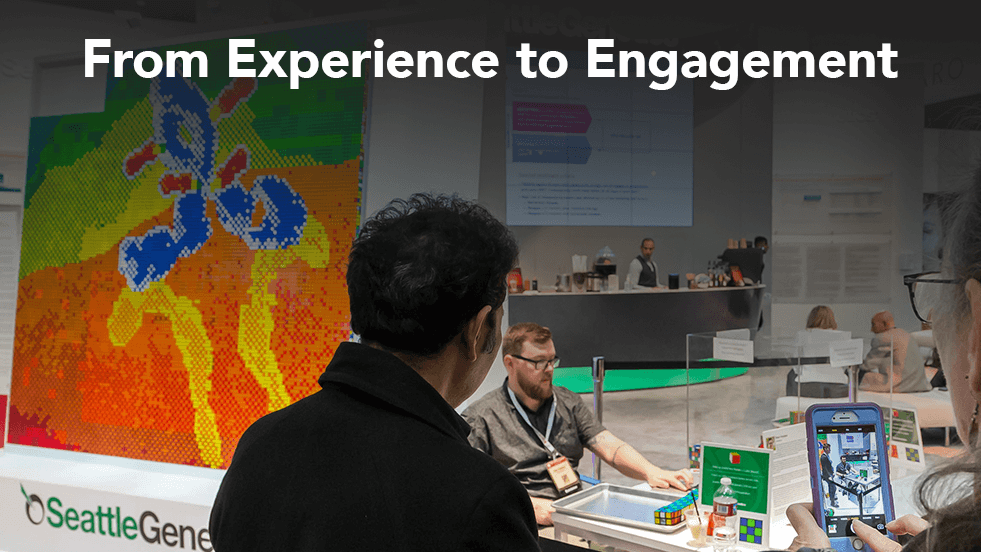A recent Event Manager Blog with the title, “35 Buzzwords Nobody Likes,” listed the two terms in our title, “experience” and “engagement” among the many overused words in our industry. There’s nothing inherently wrong with “experience” and “engagement.” The problem is that they are often used liberally in contexts where all meaning is wrung out of them. Actually, providing an experience that leads to engagement is a very powerful undertaking in face-to-face marketing, one that relies on strategy, not buzzwords.
Experience
These days you have to be pretty isolated to miss “experience.” There’s the tried and true resume “work experience.” We know, because Baby Boomer writers tell us, that Millennials want to invest in “experiences” rather than things. And of course, you have been asked many times, online and off, to rate your “shopping experience.” There’s marketing’s darling, the “brand experience.” Or Steven Soderbergh’s series on Starz, “The Girlfriend Experience.”
In the trade show universe, providing a memorable experience in an exhibit is not an afterthought, a “hey, let’s do this!” moment. The experience you want to provide for the attendee comes from your goals for exhibiting, which give rise to your strategy to take the show floor by storm with your products and messages. As you determine how to implement your strategy, you select the tactics to make it happen and figure out how to position these tactics in the exhibit environment. You work with the person designing your booth, you work with agency partners, and often, you have to work with show organizers. At this point creating an experience is light years away from using a buzzword.
In other words, when attendees walk into your exhibit, you want their experience to be immersive (not on that buzzword list, although maybe it should be) and memorable. You want them to step into your world. Have you ever been to Universal Studio’s Harry Potter World? Well, imagine yourself creating the “My Company World” where consistency and brand integrity allow visitors to become part of your corporate or product universe. As a result, exhibit visitors learn something new, which, according to many studies, is the number one reason they attend a trade show.
Engagement
Okay, moving on. We have the attendees in the exhibit, learning in and experiencing (yes, experiencing) the environment you have created. But that’s not enough, is it? When you were planning your participation in this trade show, you created measurable objectives. Perhaps those included the number of people who walked into the exhibit, but that objective, while the numbers might wow some people back in the office, doesn’t do much to determine the impact of your experience and investment in your face-to-face program. Nor does it do much to help you come up with an ROI or even an ROO (as in return on objectives—did you do what you said you were going to do?). You have to move beyond the experience.
Engagement happens when the attendee actually talks to a (well-trained) staff member who becomes a participant in the experience. The point of face-to-face marketing is to engage on a personal level with potential customers who come to the exhibit. Let’s be honest: trade shows are the last marketing initiative that allows face-to-face engagement between sellers and their markets. The end product of this engagement is to shorten the sales continuum, to reduce phone calls that go to voicemail, to connect names to real people who want to do business.
An engaged conversation in which a staff member learns:
- where prospects stand with their purchasing plans;
- what service or product the prospect is currently using;
- what next steps make sense;
goes a long way to providing real outcomes and actionable data for sales.
The most important component for facilitaing the transition from experience to engagement is to have a well-trained staff. Face-to-face is just that: people interacting. The staff needs to understand the purpose of and how to use the engagement tactics in the booth, whether those are digital tools, educational but fun games, or coffee and cookies. Engagement tactics can be high or low-tech, but they need to involve personal encounters.
The next time your team gathers and people start throwing buzzwords around the table, especially “experience” and “engagement,” challenge them to tell you what they mean. That’s always the problem with buzzwords: they are overused to the point of becoming meaningless, even when they have the potential to give you a powerful roadmap for your exhibit program.
Bravely go where buzzwords can’t. Download your free workbook, “Creative Bravery for Your Face-to-Face Marketing Program.”


